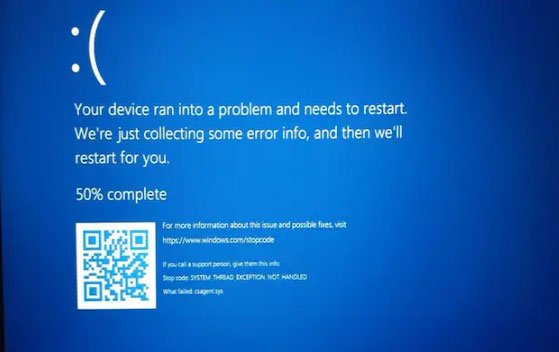Moving from on premise computing to the cloud
Moving from on premise computing to the cloud?

Before you pull the plug on your on premise computer, think about the global outage experienced by Microsoft on Thursday 7/19/2024. It was triggered by an issue with CrowdStrike’s Falcon Sensor software. Where a small mistake by a company most of us had never heard of created worldwide havoc. This problem led to widespread disruptions and caused the ‘Blue Screen of Death’ to appear on Windows PCs.
The health care and banking sectors were the hardest hit by the mishap, with estimated losses of $1.94 billion and $1.15 billion, respectively, said Parametrix, the cloud monitoring and insurance firm. Delta CEO Ed Bastian said the massive IT outage that stranded thousands of customers will cost it $500 million. Fortune 500 airlines such as American and United were the next most affected, losing a collective $860 million, Parametrix said.. The full extent of the outage’s impact on federal government operations is still unknown.
This was followed by the Tuesday 7/30/24 Microsoft Outage caused by a cyber-attack. Many users have probably forgotten or weren’t even born during the widespread malware attacks (as early as 1988 and especially in the 1990s and 2000s) which repeatedly brought down much of the internet.
Why the mayhem caused by CrowdStrike failure could happen again.
The outage has already created secondary hacking opportunities being leveraged by cybercriminals. CrowdStrike and the Cybersecurity and Infrastructure Security Agency in DHS warned that hackers targeting Latin American customers are being sent sham messages with a folder dubbed “crowdstrike-hotfix.zip” that claims to clear out the contents that enabled the outages.
There are many advantages for small businesses in using cloud computing. It enables you to do more with less, accessing critical business applications without the need to pay for ongoing maintenance or upgrades.
Centralization pressures have consolidated many industries, and, in software, the result has been that Microsoft Windows is the default operating system controlling everything from 911 systems to banks to elevators. Corporations around the world trust Microsoft to help them smoothly run their businesses.
None of this really answers the fundamental question — is cloud computing safe for your small business? The answer, as always, is not as clear as yes or no. Let’s examine the pros and cons, and the security risks.
Pros:
- Data security standards are likely to be higher in your provider’s environment than in your business, especially if the cloud provider is accredited with ISO and other key industry standards.
- Your cloud provider is likely to be better resourced physically and financially to cope with data security threats to its infrastructure than you.
- Your data will still be available, even if you lose a laptop.
Cons:
- Your data will be stored outside the business network and possibly even abroad, which may contravene local data protection laws and regulations. If your internet connection is unstable, there may be problems accessing your services.
- There are Security risks including:
- Malicious malware
- Limited visibility into network operations
- Compliance issues
- Data loss
- Data breaches
- Account hijacking
- Insider threats
In an on-premises environment, enterprises retain all their data and are fully in control of what happens to it, for better or worse. Companies in highly regulated industries with extra privacy concerns are more likely to hesitate to leap into the cloud before others because of this reason.
While the debate of the pros and cons of an on-premises environment pitted against a cloud computing environment is a real one, and one that many enterprises are having within their offices right now, there is another model that offers the best of both worlds. A hybrid cloud infrastructure could include a private cloud constructed either on premises or through a hosted private cloud provider, and effective WAN connectivity between both of those environments.
The IBM i is the closest thing to a software platform superhero that I’ve yet seen and likely the safest and most powerful server platform available. It’s virtually immune to the vast majority of malware, ransomware and Trojans. The IBM i is far more robust and vastly more resistant to outside or inside attack. It runs on premise on IBM Power Systems, ranging from IBM’s smallest to largest servers.
Additional resources of interest:
So you’re using an IBM i server
The IBM i server platform
Tags: as400, cloud computing, global outgage, IBM i, iseries, on-prem